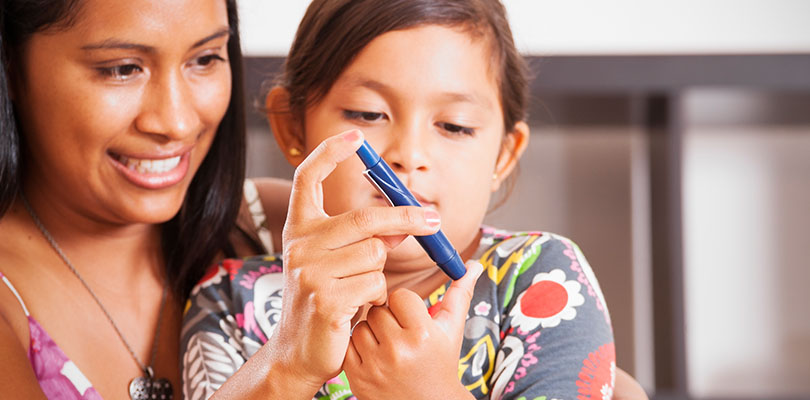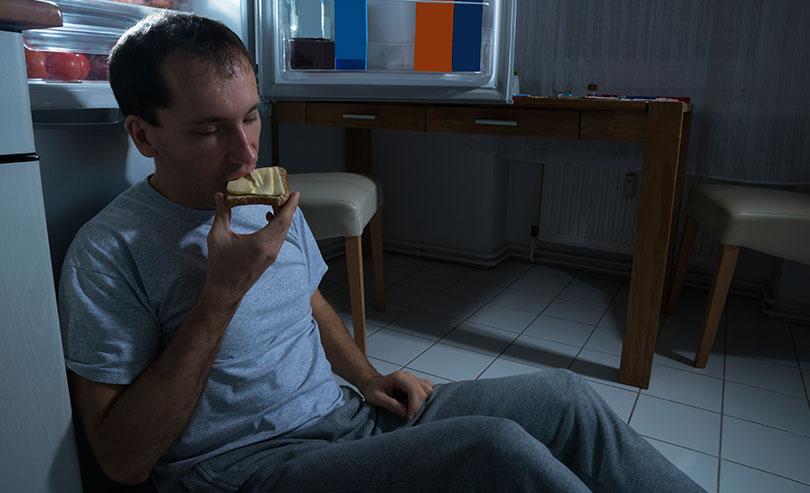What is Diabetic Shock?
It’s normal for blood glucose levels go up and down throughout the day. This has an impact on your body’s ability to function properly. If your blood glucose level dips below the healthy range, complications can arise, especially if you’re a diabetic. Therefore, it's important to be able to recognize diabetic shock.
Low blood sugar (anything below 70 mg/dL), also known as hypoglycemia, usually affects a conscious person who can treat themselves. Diabetic shock isn’t a proper medical term, but it’s used to describe an amplified state of hypoglycemia that is severe enough to require the help of another person for treatment.
When blood sugar levels drop dangerously low and become diabetic shock, a diabetic may require help because they may be unconscious, unable to speak properly, and have vision impairments. If blood sugar levels stay too low for too long, seizures or a diabetic coma can be the result.
Diabetic shock is defined more by the symptoms and need for help with treatment than defined by numbers. However, to give an idea, anything below 60 mg/dL is considered severe hypoglycemia, or diabetic shock.
Causes of Diabetic Shock
There are many reasons why someone might experience diabetic shock. Some common causes include:
- Taking insulin is the most common cause and can lead to insulin shock. For example, taking too much insulin at the time of a meal/snack.
- The timing of insulin doses. For instance, liquids absorb faster than solids, so timing the absorption of glucose can be difficult.
- Some oral medication can stimulate the pancreas to produce more insulin than the body requires.
- Skipping or delaying meals can affect blood glucose levels.
- Consuming alcohol.
- Improper doses of diabetes medication.
- Increasing activity levels without adjusting food or medication intake.
- Older age.
- Not eating enough carbohydrates.
Symptoms of Diabetic Shock
Individual reactions vary when a person experiences low blood glucose levels. Symptoms may include:
- Blurry vision
- Sweating
- Trouble speaking
- Irritability
- Confusion
- Dizziness
- Fast heartbeat
- Anxiety
- Seizures
- Reddening of the skin
- Body convulsions
- Loss of consciousness
- Jerky movements
- Clumsiness
Low blood glucose levels trigger the body to release the fight-or-flight hormone, epinephrine. This create symptoms like anxiety, a rapidly beating heart, and sweating. If blood glucose levels keep dropping and remain low for too long, symptoms worsen, and the brain is starved of glucose. When this happens, it can result in seizures, coma, and in rare cases, death.
Hypoglycemia Unawareness
Some people with longstanding diabetes may have what’s called hypoglycemia unawareness. Many who have type 1 diabetes or type 2 diabetes (and those close to them) can see the warning signs of low blood sugar levels, like irritability. When the warning signs pop up, they can take some steps to help bring up their blood glucose levels, such as having a glass of juice.
Those with hypoglycemia unawareness have either no warning signs or very subtle warning signs that their blood sugar levels are low. This is problematic since a lack of warning signs increases the risk for serious consequences regarding low blood sugar. Plus, there is less opportunity for an intervention before low blood sugar becomes diabetic shock. There is speculation that hypoglycemia unawareness may be the result of diabetes nerve damage.
Hypoglycemia unawareness occurs more often in people who:
- Have had diabetes for a long time
- Experience frequent low blood glucose levels
- Tightly control their diabetes, which increases low blood glucose reactions
Insulin Shock vs. Diabetic Shock
Both types of shock are the result of hypoglycemia (too little blood sugar). Insulin is produced by the pancreas (or injected, if the patient is a diabetic), and it lowers blood glucose.
Insulin shock is a life-threatening medical condition that requires immediate medical intervention. Insulin shock symptoms are usually the result of too much insulin in the body. It’s often found in diabetics but can occur naturally in some people if their bodies produce too much insulin. Insulin shock can happen within 15 minutes of an insulin injection or hours later, depending on which type of insulin is being used.
Symptoms of insulin shock mirror diabetic shock and include things such as an increased heart rate, sweating, dizziness, and confusion. As the symptoms worsen, the skin becomes pale and cools off, seizures may occur, the patient will become weak, and eventually pass out. The main complication with insulin shock is death, which is why 911 needs to be called immediately.
The 15-15 Rule for Hypoglycemia
If someone has low blood sugar and they’re still conscious, try to get them to ingest something sweet to intervene before their glucose levels become dangerously low.
The 15-15 rule for hypoglycemia is to test the blood sugar levels to see where they currently are. Immediately following the test, have the patient consume fifteen grams of carbohydrates (approximately 4 ounces of fruit juice or regular soda). Then, test the blood glucose levels 15 minutes later to give the sugar time to get into the blood.
If the blood glucose is still too low, repeat the process by giving them more carbs. Once their blood sugar has reached normal levels, they should eat a meal or snack.
Unlike adults, children only need six to ten grams of carbs, so check with your doctor to get dosage instructions. You can also rub honey inside their cheek if the child refuses to eat.
Holiday dinners with diabetes can be hard, especially when trying to maintain the discipline of controlling your blood sugar levels.
Diabetic Shock Treatment for Patients
If you have hypoglycemia, you’ll likely be able to treat your low blood sugar without help, although educating those around you for all contingencies is the best thing you can do.
If you have diabetes, make sure you instruct those nearest to you on what to do in the event you undergo diabetic shock. You likely won’t have the capacity to walk them through what to do in the moment once diabetic shock sets in. Your family, friends, and coworkers will feel better about what is required of them if they’re prepared in advance.
In case of an emergency, it’s advisable to have a medical ID on your person. They’re usually worn as a bracelet or necklace, and include key health information and emergency contact information. After recovery, see your doctor to come up with a game plan for preventing or minimizing diabetic shock incidents in the future.
Glucagon Kits for Patients
Severe events require greater preparation, so if you have a glucagon kit, make sure that those close to you know how to give the injection. Glucagon is a hormone produced in the pancreas that causes your liver to release glucose to the blood stream. Glucagon needs to be administered as soon as possible after the patient goes unconscious from their low blood sugar.
Glucagon kits are available by prescription, and if low blood sugar is a constant issue for you, make sure you keep the kit with you at all times. Visit your doctor to make sure that the kit is right for you. They’ll be able to properly advise how and when the kit should be used, and advise on proper storage practices.
Diabetic Shock Treatment for Caregivers
Caregivers should be given advance warning on whether or not they need to be prepared to help assist with diabetic shock. Be ready and keep foods to treat low blood sugar handy (such as hard candies) in your bag or car in case they’re required.
A person with low blood sugar may appear confused or in a drunk state, so be prepared that they may not seem like themselves. If they pass out, are difficult to control, or can’t be coerced to eat something sugary, call an ambulance. The patient will receive more immediate treatment if the ambulance comes to you than if you try to drive them to the hospital.
Glucagon Kits for Caregivers
Step one is to call 911. If they’re unconscious and you are aware of how to use the patient’s glucagon kit, you can follow the instructions to inject glucagon into the buttock, arm, or thigh. The patient will usually regain consciousness within 5–15 minutes, and may feel nauseated and/or experience vomiting, so position the person on their side to prevent choking.
If you are not familiar on how to administer glucagon, wait for the ambulance to arrive, and paramedics can treat the patient. In diabetic shock cases, do not inject insulin, as it will further reduce their blood glucose level. You also should not provide food or fluids as the patient can choke.
How to Prevent Diabetic Shock
There are a few things that you can do to help prevent diabetic shock. If you're at-risk, be aware of the following:
- The only way to know for certain if you’re experiencing low blood glucose is to check your blood glucose levels. This way you can detect and treat hypoglycemia before it becomes diabetic shock. Monitor blood sugar levels closely and check your levels often (before/after meals, before/after exercise, before bed, etc.). Make sure you’re checking more often when your habits change, such as a new work schedule, updated insulin routine, or an increase in physical activity.
- Take medication as prescribed to avoid developing long-term complications. If you’re experiencing frequent occurrences of low blood sugar, let your doctor know so they can adjust your medication.
- Don’t skip meals/snacks, especially if you’re taking insulin for diabetes. Consistency with eating helps control blood sugar levels.
- Keep a log of any low blood sugar reactions or symptoms. This will give you a road map on situations that promote low blood sugar in the body. See your doctor if you’re not sure why you’re experiencing low blood glucose levels. If you keep records of your glucose levels, exercise, food intake, and insulin schedule, your doctor will be able to make suggestions based on the data.
- If you’re consuming alcohol, make sure you’re eating at the same time. The effects of alcohol on blood sugar can be unpredictable and you need to be cognizant of any low blood sugar symptoms.
- Use continuous glucose monitors (CGM) with alarm features for low blood sugars. This is especially handy for those with hypoglycemia unawareness.
Educating those near you on what to do in the case of diabetic shock will protect you in the future. By keeping those near you prepared, they’ll be able to take care of you when you’re unable to take care of yourself.







